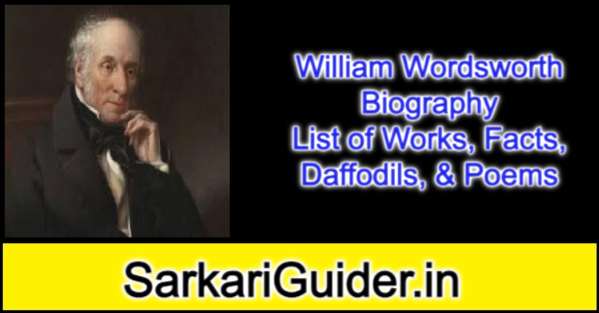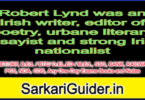William Wordsworth Biography

William Wordsworth Biography
Life and Works –
William Wordsworth Biography – Born on 7th April, 1770, at Cocker mouth. Cumberland. Wordsworth was the Second of Five Children. His father, John Wordsworth, attorney-at-law, and his mother found their second son William to be a remarkable boy from the very beginning. William was a boy of moody and violent temper which caused a great anxiety to the parents. William was rather unlucky in the sense that he lost his mother when he was only eight years old, and father when only fourteen. The poet could be educated only by the generosity of his uncles.
Wordsworth was sent to school at Howkshead where he studied “Don Quixote”. “Gúlliver’s Travels” and The Tales of a Tub with great interest. However, the Country world was his real education. As the point himself says in the Prelude, even his moral nature was formed in the school of Dame Nature. Wordsworth entered St. John’s College, Cambridge in 1787. interest in self-chosen reading and his communion with Nature. It was Dame Nature. Wordsworth entered St. John’s College, Cambridge in 1787.
He did not care much for the university curriculum, as he took greater during this period that in the company of his sister, Wordsworth met Mary Hutchinson whom he married later on. With a college friend, he went on a walking tour of France and Switzerland. He landed at Calais on the very eve of that great federal and when the tree of liberty were planted all over France. Wordsworth took his B.A. Degree in 1791, and then settled in London with no definite plans for his future career. Most of his time was passed in rambling through the streets of London and the rush and roar of the city badly disgusted him. His further visits to France developed his revolutionary
radour and he seriously contemplated of putting himself forward as a leader of the Girondist party. It was also during his visit to France that he fell violently in love with Annette Vallon and had a daughter Caroline, by her His affair with Annette brought a blot on his fairname. Lateron, about 1795, he came in contact with Coleridge and their freindship continued for the whole life. The epoch making “Lyrical Ballads” published in 1798, was the result of their close companionship. In 1802 Wordsworth married Hutchinson and lived a life of peace and felicity. It was during this period that the poet composed the bulk of his best poetry.
The rest of Wordsworth’s life is almost uneventful. Travelling was a passion with the poet which remained throughout his life upto the end. Wordsworth died of pleurisy in the years, 1850.
His works and evolution of his genius – Wordsworth lived a long life and his poetic span covers a period of more than sixty year. As a Voluminious writer, Wordsworth has produced a huge bulk of poetry. However, much of his composition appears to be prosaic and dull. Arnold, therefore, suggests that Wordsworth must be read through a selection in order to be well appreciated. His best works were produced during 1797-1807. After this period there is marked a significant decay in his poetic genius.
1. The Early Period –
It consists of the period before 1791. During this period, the peot composed some well-known poems such as the “Descriptive Sketches” and “Evening Walk”. Both these poems are in the orthodox heroic couplet and remind us of the conventional 18th century poetic style. However, a personal and distincitive Quality can be observed in the passages dealing with Nature.
2. The Period of Gloom –
The period of guilt and remorse extends from 1792 to 1797. On account of his affair with Annette Vallon, a sense of guilt haunted him. His feeling of remorse and his gloom find expression in the unsuccessful tragedy. ‘The Borders’, ‘Guilt and Sorrow’, and
3. The Glorious Decade –
‘During the glorious decade between 1797 and 1807. Wordsworth’s poetic power was at its Zenith. The chief achievements of this remarkable decade contained ‘The Lyrical Ballads’ with admirable pieces such as “Lines Written in Early Spring”, “Michael”, “Fountain”, etc. “Peter Bell”, “Lucy” group of poems, ‘Nutting” and “Ruth”. A touch of Spirituality can be noted in these poems. This period also witnessed the composition of ‘The Prelude’ or the account of the growth of a poet’s mind, which was commenced in 1799 and completed in 1805. This autobiographical poem running into fourteen books was intended to form a part of the philosophical epic, “The Recluse”, which, however, could never be written. Among some other significant works of this period are the great “Immortality Ode” and two volumes of his poetry which contain famous poems such as “Ode to Duty”, “Highland Girl”, “Solitary Reapaer”. “afflication of Margret”, “Happy Warrior”, “Resolution and Independence”, “Peele Cestle”. “To the cuckoo”, “My Heart leaps up”, and “I wandered lonely as a cloud” etc. During this period, Wordsworth also produced “The excursion” which was publsihed in 1814 along with these works. Wordsworth has composed more than five hundred sonnets.
4. The Period of Decline –
The period of decline extended from 1808 to 1850. It seems that after 1807 the poet’s power began to decline. The lines composed upon an “Evening of Extraordinary Splendour” and “Beauty” illustrate last glimpses of the poet’s genius. After that his genius revived only occasionally in fitful and momentary flashes. Some pieces belonging to this period are “Laodamia”. “The River Duddon” “Ecclesiastical Sketches”, “Sonnets on the Punishment of Death” “Lines Written on the Death of Charies Lamb”, etc.
Wordsworth was not only a great poet, he was also an eminent literary critic. His Preface to the lyrical Ballads is a great critical document of abiding significance. It has rightly been regarded as “The manifesto of English Romantic movement” and “The dividing line between the 18th and 19th century literary Theories.”
William Wordsworth as a Romantic Poet
William Wordsworth as a poet of Nature
William Wordsworth as a writer of sonnets.
Important Links
Metaphysical Poetry: Definition, Characteristics and John Donne as a Metaphysical Poet
John Donne as a Metaphysical Poet
Shakespeare’s Sonnet 116: (explained in hindi)
What is poetry? What are its main characteristics?
Debate- Meaning, Advantage & Limitations of Debate
Sarojini Naidu (1879-1949) Biography, Quotes, & Poem Indian Weavers
Charles Mackay: Poems Sympathy, summary & Quotes – Biography
William Shakespeare – Quotes, Plays & Wife – Biography
Ralph Waldo Emerson – Poems, Quotes & Books- Biography
What is a lyric and what are its main forms?






